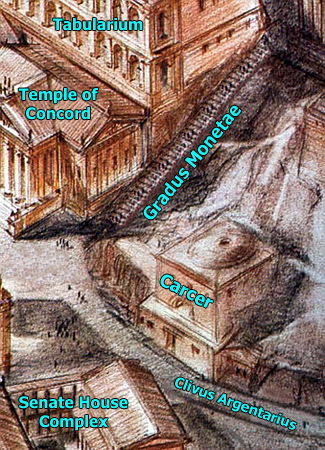
Your knees begin to tremble as you look up the long stone staircase that climbs from the Forum up to the summit of the Arx. The trembling is due as much to the dark history of these stairs as to their steepness and height, for this was the place where the corpses of executed traitors and political criminals were thrown to be spat upon and abused by passersby and to rot in the sun.
The entire staircase was apparently originally known as the Gradus Monetae, named after the Temple of Juno Moneta where the stairs end. However, the first section of the stairs leading up to the Tarpeian Rock may have also been called Centum Gradus ("the Hundred Steps"). From the time of Tiberius, these lower steps were referred to as the Scalae Gemoniae ("the Gemonian Steps" or just "the Gemonian"). The Gemonian Steps were part of Roman spectacle, a theatrical way to extend the punishment of political offenders even beyond their deaths by exposing their corpses to public view and humiliation and then dragging them to the Tiber river with an iron hook, thus preventing proper burial. It is no wonder that Valerius Maximus refers to "the accursed disgrace of the Gemonian Steps," detestanda Gemoniarum scalarum nota (Facta et Dicta Memorabilia 6.3.3).
Even an emperor was once cast onto the Gemonian Steps. Aulus Vitellius, who ruled very briefly during the civil wars that followed the death of Nero, was dragged to the Gemonian Steps by soldiers of the conquering Vespasian and reviled and executed on the staircase in 69 CE. One of the most dramatic stories that unfolded here was the downfall of Lucius Aelius Sejanus in 31 CE. Sejanus had risen to the position of Prefect of the Praetorian Guard under Tiberius, and he became a virtual dictator in the city of Rome after Tiberius moved to the island of Capri in 26 CE. Sejanus' iron-fisted tactics and elimination of rivals (including members of Augustus' family) made him feared and hated by senators and people alike. When Tiberius suddenly turned against Sejanus and had him arrested, mobs tore down statues of Sejanus all over the city, and Sejanus himself was executed and his body thrown on the Gemonian Steps, "where the rabble abused it for three whole days and afterwards threw it into the Tiber" (Cassius Dio, Roman History 58.11.5).